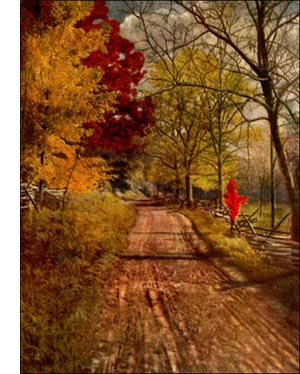Loblolly or Old Field Pine Tree
 Loblolly, or Old-Field Pine (P. Taeda, Linn.) A tall, straight, deep-rooted tree, 8o to 100 feet high, with short, muchbranched horizontal limbs. Bark bright red-brown, broadly ridged, scaly; branchlets smooth, yellow-brown, thickly set with the recurved inner scales of the branch buds. Wood resinous, weak, coarse grained, pale brown. Butts obovate-oblong, with pointed brown scales. Leaves in threes, slender, stiff, twisted, pale green, glaucous, 6 to 10 inches long; sheaths close, thin, persistent. Flowers: staminate, crowded on short spikes, incurved, cylindrical, in scaly involucres; pistillate, lateral, one to three in a cluster, below apex of new shoot, with yellow scales, oval on short, scaly stalks, April. Fruits ovate-oblong, 3 to 5 inches long, ii to 2 inches broad; ridged, purplish knobs, with prickles on scales; seeds, rhomboidal, with wing 3/4 inch long. Preferred habitat, swampy lands near tidewater; low ground, sterile and worthless. Distribution intermittent, New Jersey (Cape May), south along coast to Tampa Bay and Texas. Inland, from the Carolinas to Arkansas and Louisiana. Uses : Lumber not distinguished from longleaf or yellow pine-shipped north in quantities. Used in heavy construction-building of docks, ships, cars and houses. Valuable tree for reforesting waste land, and for fuel.
Loblolly, or Old-Field Pine (P. Taeda, Linn.) A tall, straight, deep-rooted tree, 8o to 100 feet high, with short, muchbranched horizontal limbs. Bark bright red-brown, broadly ridged, scaly; branchlets smooth, yellow-brown, thickly set with the recurved inner scales of the branch buds. Wood resinous, weak, coarse grained, pale brown. Butts obovate-oblong, with pointed brown scales. Leaves in threes, slender, stiff, twisted, pale green, glaucous, 6 to 10 inches long; sheaths close, thin, persistent. Flowers: staminate, crowded on short spikes, incurved, cylindrical, in scaly involucres; pistillate, lateral, one to three in a cluster, below apex of new shoot, with yellow scales, oval on short, scaly stalks, April. Fruits ovate-oblong, 3 to 5 inches long, ii to 2 inches broad; ridged, purplish knobs, with prickles on scales; seeds, rhomboidal, with wing 3/4 inch long. Preferred habitat, swampy lands near tidewater; low ground, sterile and worthless. Distribution intermittent, New Jersey (Cape May), south along coast to Tampa Bay and Texas. Inland, from the Carolinas to Arkansas and Louisiana. Uses : Lumber not distinguished from longleaf or yellow pine-shipped north in quantities. Used in heavy construction-building of docks, ships, cars and houses. Valuable tree for reforesting waste land, and for fuel.There is probably no pine tree that has more nicknames than this, nor one more variable in its habits of growth and in the quality of its wood. " Old-field " and " meadow pine " refer to its habit of invading land abandoned by farmers. " Sap," "frankincense " and " torch pine " mean that it is rich in resin. Several local names refer to its long leaves; others to the dark colour of its bark. Some names are meaningless.
The loblolly pine is one which Nature seems to have favoured in the race for life. It bears seed copiously every year. It has remarkable vitality of seed and seedlings. It chooses low, watersoaked ground, or rolling upland terraces where soil is light and sandy, though wet, and where there are comparatively few trees to contend with. The young trees grow with tremendous vigour for the first ten years, crowding so that animals cannot get in to harm them. After that they are beyond this danger, and their struggle is among themselves. Fires do little harm in the marshy regions, so that these forests have a great advantage over others. The trees are deep rooted, and in spite of fungus and insect attacks, thrive throughout the Southern States.
In Michaux's travels he noted that three-fourths of the houses of lower Virginia were built of loblolly pine. Giant trees grew there, and down in the rich marsh lands that reached back from Pamlico and Albemarle Sounds the finest specimens of these loblolly pines furnished the navies of many countries with masts unsurpassed in quality and size. These were of the famous " rosemary pine," heavy, hard, fine-grained heart wood, with a thin rind of sap wood. Now they are all gone, practically, and there are left the slash pines, coarse grained, with half their diameter sap wood. Virgin woods and second growth furnish the mills with lumber which is not distinguished in the trade from longleaf pine, though inferior to
it. The third grade of lumber, with sap wood three times as thick as heart wood, and exceedingly coarse grained, is known to lumbermen as old-field pine, and is locally consumed as lumber and fuel in the coast regions. Its poor quality is the result of very rapid growth.
"Kiln-drying" of the lumber has greatly improved its quality by adding to the durability and hardness of it. Heat kills a fungus which in ordinary seasoning turns the wood blue. Loblolly timbers are made durable by the " creosoting " process. Though rich in resin, the tree is not one which yields resinous substances, such as turpentine and pitch, for when tapped there is scarcely any flow, and contact with the air hardens the little resin that starts. As a fuel tree the cheap loblolly pine is unexcelled. It gives a quick, intense heat when dried, and is used in bakeries, kilns and in charcoal burning.